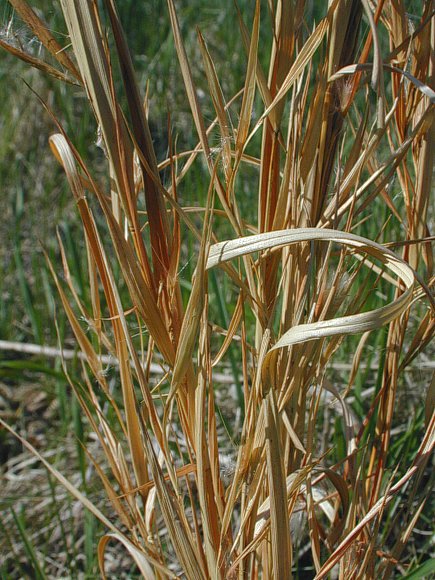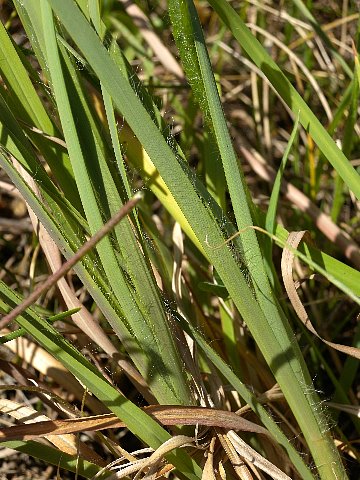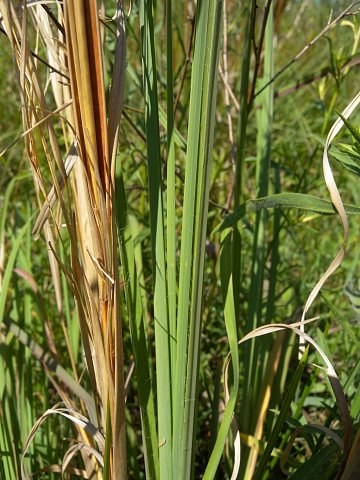
The upper secondary culms develop clusters of 2-4 racemes of spikelets. Individual racemes are ¾-1½" long, erect or ascending, and partially hidden by their sheaths. Along the rachis of each raceme, there are several pairs of spikelets. Each pair of spikelets consists of a sessile spikelet (3-4 mm. long) with a perfect floret and a short pedicel (4-5 mm. long) with an empty (or missing) spikelet; sometimes an awn-like scale (less than 0.5 mm. long) is present at the apex of the pedicel. Each pedicel is covered with long white hairs. At the base of the sessile spikelet, there is a small tuft of white hairs. The sessile spikelet consists of a linear-lanceolate glume, a linear-lanceolate lemma with an awn, and a membranous palea enclosing one side of the floret. Both the glume and lemma are keeled. The slender awn of the lemma is 8-20 mm. long, straight or slightly curved, and not twisted nor sharply bent toward the base. The perfect floret consists of an ovary with a pair of feathery stigmata and a single stamen. The blooming period occurs during late summer or early fall for about 1-2 weeks. The florets are wind-pollinated. Afterwards, fertile florets are replaced by elongated grains about 2.5-3.0 mm. long; the latter are blown about to some extent by the wind. The root system consists of a dense crown of fibrous roots.

Cultivation: The preference is full sun, dry conditions, and a barren soil containing clay, sand, gravel, or rocky material. However, partial sun and more mesic conditions are also tolerated. The dried-out foliage of this grass remains erect and persists throughout the winter into the summer of the following year. This warm-season grass has a C4 metabolism, enabling it to withstand hot dry weather. Most growth and development occurs during the summer and early fall. There is some evidence that the decayed foliage is phytotoxic.
Range & Habitat: The native Broom Sedge is occasional to locally common in the southern half of Illinois and in the NE section of the state (see Distribution Map). The range of this grass may be slowly expanding northward. Habitats include hill prairies, upland sand prairies, upland clay prairies, upland savannas, upland sandy savannas, rocky glades, sandy or gravelly areas along railroads, pastures, abandoned sandy fields, open areas of parks, mined land, and barren waste areas. This grass tends to colonize open areas with infertile soil that have been subjected to a history of disturbance, whether from occasional wildfires, grazing, or other causes. Because the dried-out older foliage of this grass is so persistent, it increases the risk of ground fires in some habitats substantially.

Faunal Associations: Various insects feed on Broom Sedge. These insects include the leafhoppers Stirellus bicolor and Polyamia caperata, the piglet bugs Bruchomorpha dorsata and Bruchomorpha jocosa, the scale insect Aclerda andropogonis, the thrips Plesiothrips andropogoni and Eurythrips hindsi, the leaf beetles Chaetocnema denticulata and Myochrous denticollis, Sphenophorus destructor (Destructive Billbug), caterpillars of Hesperia metea (Cobweb Skipper), and Dissosteira carolina (Carolina Grasshopper). Because of the persistence of the dried-out foliage throughout the winter and into the summer of the following year, this bunchgrass provides shelter for various insects during the winter. It also provides cover and nesting habitat for the Bobwhite Quail, Greater Prairie Chicken, and other wildlife. Birds eating the seeds of Broom Sedge during the winter include the Slate-Colored Junco, Field Sparrow, and Tree Sparrow. The young foliage of this grass is palatable to cattle, deer, buffalo, and other hoofed mammalian herbivores, although older foliage declines in value as a source of forage.
Photographic Location: An open grassy area of a park in Vermilion County, Illinois, and a degraded prairie at Parkland College in Champaign, Illinois.

Comments: The most striking aspect of Broom Sedge is the persistence of its dried straw-colored foliage. This foliage tends to stand out from the background as this grass prefers habitats that are relatively barren. The common name, 'Broom Sedge,' is somewhat misleading because this species is a grass (Poaceae), rather than a sedge (Cyperaceae). The 'broom' in the common name refers to the fact that the culms were used to make brooms in some of the southern states. Another common name that is occasionally used for this species is 'Whiskey Grass.' It is possible to confuse Broom Sedge with some closely related species of grass, but they are restricted to southern Illinois and areas further south. These species include Andropogon glomeratus (Bushy Broom Sedge), Andropogon ternarius (Silver Broom Sedge), and Andropogon gyrans (Elliott's Broom Sedge). As compared to Broom Sedge, Bushy Broom Sedge has a more bushy inflorescence with wider spikelets (exceeding ¾" across). The spikelets of Silver Broom Sedge are more heavily covered with silver hairs, its sessile spikelets are longer (5-6 mm. in length), and each of its florets has 3 stamens, rather than a single stamen. Elliott's Broom Sedge can be distinguished by its upper sheaths that are more swollen and copper-colored, its racemes of spikelets that are mostly enclosed by these sheaths, and awns that are twisted or bent near their bases.